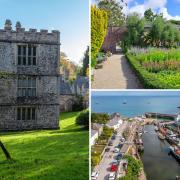Rupert Kirkwood tells Cornwall Life about his 700-mile long kayaking adventure up every
creek, inlet and cave of Cornwall's coastline
Rupert Kirkwood tells Cornwall Life about his 700-mile long kayaking adventure up every creek, inlet and cave of Cornwall’s coastline
Since moving to the South West in 1983 I have spent as much time as possible on, in, or near the sea. I bought a kayak and disappeared off to some remote corners of the coast, which ticked all the right boxes for me in terms of adventure, jaw-dropping scenery and a stream of wildlife encounters. So I planned a complete tour of the entire coastline of Cornwall by kayak. This has been done before but I’m quite sure no one else has been daft enough to paddle around every single bay, up every inlet, creek and culvert, and even into the back of every cave. This gives a total distance of just over 700 miles, and I have enjoyed every single yard of it.
The development of sit-on-top kayaks, about 15 years ago, stimulated my interest in long-distance coastal touring. They are made of indestructible plastic and the cockpit is recessed into the top deck with a comfy seat. If you choose a fairly long kayak, say 13-15ft long, you can clock up to 30 miles a day in a fair degree of comfort.
So let’s give you the kayaker’s view of the Cornish coast going round clockwise from the tidal limit of the Tamar at Gunnislake weir. The River Tamar, heaving in history, takes you past the front door of Morwellham Quay. Suddenly, round a bend, is the highest viaduct you could imagine at Calstock. There’s plenty more interest in the lower Tamar as you glide underneath the Royal Albert Bridge. Heading out into the open sea past Plymouth breakwater, I also took a jaunt to the Eddystone Rocks and the renowned lighthouse, 12 miles offshore.
The south coast of Cornwall has got sandy beaches, plunging cliffs, picturesque fishing villages and hundreds of miles of sheltered estuaries. The estuaries in Looe and Fowey provide excellent winter paddling when the open sea is unwelcoming. Further west, the huge expanse of Carrick Roads can absorb you for entire days. One of my favourite trips is up the Fal River beyond the King Harry Ferry to see giant redundant container and car transporter ships that are moored in the narrowest stretches of river.
It’s the wildlife that really drives me on to keep paddling the same stretch of sea, or battling into a headwind and heavy seas for hours. The birds in Cornwall alone show a huge variety, from dippers, kingfishers and dabchicks in the upper rivers, estuarine waders like redshank, greenshank and curlew, as well as birds of the open sea such as wintering divers and grebes, breeding guillemots, razorbills and puffins, and a constant flypast of gannets and shearwaters, with even the odd storm petrel in the summer. Not forgetting the most exciting bird in the world – the peregrine falcon. To witness the incredible speed of one in full stoop at a passing wader is right up there at the top of the list of nature’s thrills.
At Lizard Point I had my first really close encounter with a grey seal. I took this big bull seal completely by surprise as it slept, snoring loudly, oblivious to my silent approach. Even after I gently nudged it with the end of my kayak it took a while to wake up and come to life – a teenager perhaps?
St Michael’s Mount is a suitably dramatic guardian of my favourite part of Cornwall – the Land’s End peninsula. Deep, swirling waters and big tides mean loads of marine life and here I witnessed a performance by a pod of bottle-nosed dolphins right in front of the Minack Theatre. Kayaking with basking sharks will get your pulse racing; they are commonly 30ft long and much wider than a kayak. They detect your approach when you are about 50yds away, the dorsal fin will then disappear and the next you know they appear right next to, or just beneath, your boat.
I spent five days exploring the Isles of Scilly last June and travelled on the Scillonian with five other members of the Bude Old Gits Kayak Fishing Club. We paddled round most of the islands, basked on beaches of white sand, ventured out to the Bishop Rock lighthouse, and camped in the most beautiful sites. One day, about ten miles offshore, we saw something that resembled a floating car roof. My friend, first on the scene, announced it was a turtle. It was, in fact, a Leatherback turtle and I am fairly sure we are the only kayakers ever to have seen one in UK waters.
The north Cornwall coast is rarely without swell. I chose my days here carefully after studying wind, swell and tide. Even further north, Boscastle can claim a lot of kayaking ‘bests’: the biggest breeding seabird colonies of mainland Cornwall, with rows of gillemots and razorbills and a few pairs of puffins, which are very tame; the biggest sea cliffs in Cornwall beneath which is the biggest grey seal colony, and some of the biggest and deepest sea caves in the county.
Back towards my home patch, the headlands south of Bude provided many memorable kayak fishing sessions with most recent exploits involving shark fishing. The final stretch of Hartland coast up to the border with Devon featured a succession of hull-tearing reefs far out to sea. There’s so much more to enthuse about on this trip; I haven’t even mentioned my encounter with a badger swimming in the sea, or meetings with otters, deer and porpoises. What an adventure!


























